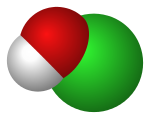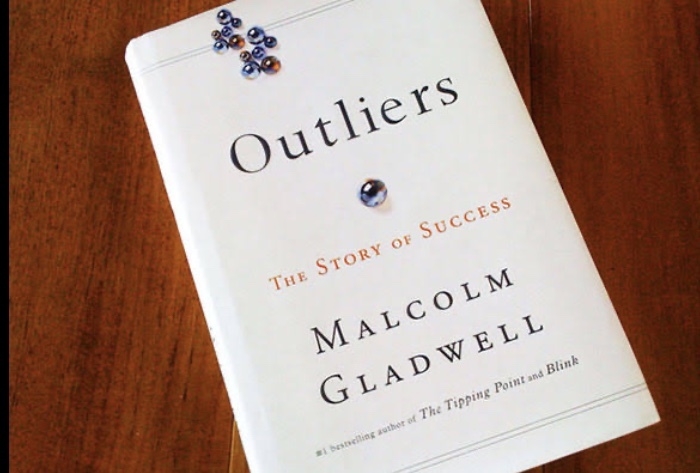Acid hypochlorơ
| Acid hypochlorơ | |
|---|---|
 hypochlorous acid bonding | |
 hypochlorous acid space filling | |
| Danh pháp IUPAC | acid hipoclorơ, cloranol, Hydroxideôclorin |
| Tên khác | hydro hypôcloric, clorin Hydroxide |
| Nhận dạng | |
| Số CAS | |
| Số EINECS | |
| Ảnh Jmol-3D | ảnh |
| SMILES | đầy đủ
|
| Thuộc tính | |
| Công thức phân tử | HClO |
| Khối lượng mol | 52.46 g/mol |
| Bề ngoài | Chất lỏng không màu |
| Khối lượng riêng | Thay đổi |
| Điểm nóng chảy | |
| Điểm sôi | |
| Độ hòa tan trong nước | Tan |
| Độ axit (pKa) | 7.497[1] |
| Cấu trúc | |
| Các nguy hiểm | |
| Nguy hiểm chính | oxy hóa |
| Các hợp chất liên quan | |
| Hợp chất liên quan | Clo Calci hipoclorit Natri hipoclorit |
Trừ khi có ghi chú khác, dữ liệu được cung cấp cho các vật liệu trong trạng thái tiêu chuẩn của chúng (ở 25 °C [77 °F], 100 kPa). | |
Acid hypochlorơ là một acid yếu, có công thức hóa học là HClO (trong một số ngành công nghiệp, acid hypochlorơ còn có công thức hóa học là HOCl). Acid này được tạo thành khi chlor tan trong nước. Acid hypochlorơ không thể được tách thành nguyên chất, do các quá trình cân bằng giữa các tiền chất của nó diễn ra rất nhanh. HClO được sử dụng làm chất tẩy trắng, chất oxy hóa, chất khử mùi và chất sát trùng.
Ứng dụng
[sửa | sửa mã nguồn]Trong tổng hợp hữu cơ, HClO chuyển alken thành chlorohydrin (halohydrin).[2]
Trong sinh học, acid hypochlorơ góp phần hoạt hoá các bạch cầu trung tính bằng cách peroxi hóa các ion chlorit, diệt vi khuẩn, được dùng trong xử lý nước, như là chất tiệt trùng trong các hồ bơi.[3][4][5]
Trong cung cấp nước và thực phẩm, những thiết bị đặc biệt tạo ra dung dịch HClO yếu từ nước và muối thường được sử dụng để tạo ra một lượng vừa đủ các chất diệt khuẩn an toàn hơn (do tính chất không bền của nó) nhằm xử lý bề mặt thực phẩm trước khi chế biến cũng như trong cung cấp nước.[6][7]
Cấu tạo, độ bền và phản ứng hoá học
[sửa | sửa mã nguồn]Khi cho khí chlor vào nước sẽ tạo ra cả hai acid hydrochloric và acid hypochlorơ [8]:
- Cl2 + H2O ⇌ HClO + HCl
Khi acid được cho vào các muối ngậm nước của acid hypochlorơ (như natri hypochlorit trong các dung dịch tẩy trắng trong công nghiệp) thì phản ứng này sẽ xảy ra theo chiều nghịch, giải phóng khí chlor. Do đó, dung dịch tẩy trắng chứa chlorit thì bền vững hơn khi hoà tan khí chlor vào dung dịch kiềm, như natri hydroxide.
Acid cũng được điều chế bằng cách hoà tan Dichlor monoxide trong nước; dưới điều kiện ngậm nước tiêu chuẩn các acid anhydrơ hypochlorơ sẽ không thể được điều chế do sự chuyển dịch theo chiều nghịch trong cân bằng hoá học giữa nó và anhydric[9]:
- 2HOCl ⇌ Cl2O + H2O K(0°C) =3.55x10-3dm³mol-1
Sự có mặt của ánh sáng hay sự chuyển thành oxide kim loại của đồng, nickel hay cobalt sẽ tăng tốc sự phân huỷ thành acid hydrochloric và khí oxy[9]:
- 2Cl2 + 2H2O → 4HCl + O2
Phản ứng hoá học
[sửa | sửa mã nguồn]Trong dung dịch hay ở dạng ngậm nước, acid hypochlorơ bị phân giải riêng biệt thành anion hypochlorit OCl−:
- HClO ⇌ OCl− + H+
Các muối acid hypochlorơ thì được gọi là các hypochlorit. Một trong những hypochloríc được biết đến nhiều nhất là NaClO, một chất độn hoạt động mạnh trong chất tẩy rửa.
HClO có tính oxi hoá mạnh hơn khí chlor ở điều kiện chuẩn.
- 2 HClO(aq) + 2 H+ + 2 e− ⇌ Cl2(g) + 2 H2O E=+1.63V
HClO phản ứng với HCl để giải phóng khí chlor:
- HClO + HCl → H2O + Cl2
Khả năng phản ứng của HClO với các phân tử sinh học
[sửa | sửa mã nguồn]Acid hypochlorơ phản ứng với các phân tử sinh học rất đa dạng như DNA, RNA,[10][11][12][13] nhóm các acid béo, cholesterol[14][15][16][17][18][19][20][21] và protein.[17][22][23][24][25][26][27]
Khả năng phản ứng với các nhóm sulfhydryl protein
[sửa | sửa mã nguồn]Knox et al là người đầu tiên chú ý rằng HClO là một chất ức chế sulfhydryl, với một lượng vừa đủ, nó có thể ức chế hoàn toàn các protein chứa nhóm sulfhydryl. Điều này xảy ra do HClO oxy hóa được nhóm sulfhydryl, thành phần chính của các cầu nối disulfide[28], là liên kết ngang của các phân tử protein.[24] Một sulfhydryl-chứa amino acid có thể làm sạch đến bốn phân tử HOCl.
Phản ứng với nhóm amino protein
[sửa | sửa mã nguồn]Acid hypochlorơ có thể phản ứng hoàn toàn với các amino acid có chuỗi các nhóm amino, với chlor từ HClO thay thế hydro, kết quả là tạo ra các chất hữu cơ chloramin.[29] Các amino acid được chlor hoá nhanh chóng phân huỷ, trừ protein chloramin thì tồn tại lâu hơn và giữ lại khả năng oxy hóa.[27] Kết luận từ các kết quả của họ rằng hầu hết các chất hữu cơ chloramin bị phân huỷ do sự sắp xếp lại bên trong và càng có ít hơn các nhóm NH2 tham gia phản ứng với chuỗi peptit, dẫn đến sự phân cắt protein.
Muối hypochlorit
[sửa | sửa mã nguồn]Hypochlorit là các muối của acid hypochlorơ. Các muối hypochlorit thường gặp là calci hypochlorit, natri hypochlorit.
Điều chế muối hypochlorit bằng điện phân
[sửa | sửa mã nguồn]Các muối hypochlorit có thể được điều chế bằng cách điện phân các dung dịch chứa chlor. Khí chlor được điều chế ở cực âm, khí hydro được điều chế ở cực dương. Một phần khí chlor điều chế được sẽ tan, tạo thành các ion hypochlorit. Muối hypochlorit còn được điều chế bằng cách cho một lượng không cân đối khí chlor vào dung dịch kiềm.
An toàn
[sửa | sửa mã nguồn]HClO là chất oxy hóa mạnh và có thể tạo ra các vụ nổ hóa chất.
Xem thêm
[sửa | sửa mã nguồn]- Dichlor monoxide: oxide acid tương ứng
Liên kết ngoài
[sửa | sửa mã nguồn]- Reuters - Mystery solved: How bleach kills germs (tiếng Anh)
Tham khảo
[sửa | sửa mã nguồn]- ^ Morris, J. C. (1966), “The acid ionization constant of HClO from 5 to 35 °”, J. Phys. Chem., 70: 3798–3805, doi:10.1021/j100884a007
- ^ Unangst, P. C. "Hypochlorous Acid" in Encyclopedia of Reagents for Organic Synthesis (Ed: L. Paquette) 2004, J. Wiley & Sons, New York. doi:10.1002/047084289X.rh073
- ^ Harrison, J. E.; J. Schultz (1976). “Studies on the chlorinating activity of myeloperoxidase”. Journal of Biological Chemistry. 251 (5): 1371–1374. doi:10.1016/S0021-9258(17)33749-3. PMID 176150.
- ^ Thomas, E. L. (1979). “Myeloperoxidase, hydrogen peroxide, chloride antimicrobial system: Nitrogen-chlorine derivatives of bacterial components in bactericidal action against Escherichia coli”. Infect. Immun. 23 (2): 522–531. doi:10.1128/IAI.23.2.522-531.1979. PMC 414195. PMID 217834.
- ^ Lỗi chú thích: Thẻ
<ref>sai; không có nội dung trong thẻ ref có tênref32 - ^ Disinfection of Facility H2O Lưu trữ 2019-01-22 tại Wayback Machine.
- ^ Water Works: Hyatt's New Disinfectant/Cleaner Comes from the Tap, Bloomberg Businessweek.
- ^ Fair, G. M., J. Corris, S. L. Chang, I. Weil, and R. P. Burden. 1948. The behavior of chlorine as a water disinfectant. J. Am. Water Works Assoc. 40:1051-1061.
- ^ a b Inorganic chemistry, Egon Wiberg, Nils Wiberg, Arnold Frederick Holleman, "Hypochlorous acid" p.442, section 4.3.1
- ^ Albrich, J. M., C. A. McCarthy, and J. K. Hurst. 1981. Biological reactivity of hypochlorous acid: Implications for microbicidal mechanisms of leukocyte myeloperoxidase. Proc. Natl. Acad. Sci. USA 78:210-214.
- ^ Dennis, W. H., Jr, V. P. Olivieri, and C. W. Krusé. 1979. The reaction of nucleotides with aqueous hypochlorous acid. Water Res. 13:357-362.
- ^ Jacangelo, J. G., and V. P. Olivieri. 1984. Aspects of the mode of action of monochloramine. In R. L. Jolley, R. J. Bull, W. P. Davis, S. Katz, M. H. Roberts, Jr., and V. A. Jacobs (ed.), Water Chlorination, vol. 5. Lewis Publishers, Inc., Williamsburg.
- ^ Prütz, W. A. 1998. Interactions of hypochlorous acid with pyrimidine nucleotides, and secondary reactions of chlorinated pyrimidines with GSH, NADPH, and other substrates. Arch. Biochem. Biophys. 349:183-191.
- ^ Arnhold, J., O. M. Panasenko, J. Schiller, Y. A. Vladimirov, and K. Arnold. 1995. The action of hypochlorous acid on phosphatidylcholine liposomes in dependence on the content of double bonds. Stoichiometry and NMR analysis. Chem. Phys. Lipids 78:55-64.
- ^ Carr, A. C., J. V. D. Berg, and C. C. Winterbourn. 1996. Chlorination of cholesterol in cell membranes by hypochlorous acid. Arch. Biochem. Biophys. 332:63-69.
- ^ Domigan, N. M., M. C. M. Vissers, and C. C. Winterbourn. 1997. Modification of red cell membrane lipids by hypochlorous acid and haemolysis by preformed lipid chlorhydrins. Redox Rep. 3:263-271.
- ^ a b Hazell, L. J., J. V. D. Berg, and R. Stocker (1994). “Oxidation of low density lipoprotein by hypochlorite causes aggregation that is mediated by modification of lysine residues rather than lipid oxidation”. Biochem. J. 302: 297–304. PMC 1137223. PMID 8068018.Quản lý CS1: nhiều tên: danh sách tác giả (liên kết)
- ^ Hazen, S. L., F. F. Hsu, K. Duffin, and J. W. Heinicke. 1996. Molecular chlorine generated by the myeloperoxidase-hydrogen peroxide-chloride system of phagocytes converts low density lipoprotein cholesterol into a family of chlorinated sterols. J. Biol. Chem. 271:23080-23088.
- ^ Vissers, M. C. M., A. C. Carr, and A. L. P. Chapman. 1998. Comparison of human red cell lysis by hypochlorous acid and hypobromous acids: insights into the mechanism. Biochem. J. 330:131-138.
- ^ Vissers, M. C. M., A. Stern, F. Kuypers, J. V. D. Berg, and C. C. Winterbourn. 1994. Membrane changes associated with lysis of red blood cells by hypochlorous acid. Free Rad. Biol. Med. 16:703-712.
- ^ Winterbourne, C. C., J. V. D. Berg, E. Roitman, and F. A. Kuypers. 1992. Chlorhydrin formation from unsaturated fatty acids reacted with hypochlorous acid. Arch. Biochem. Biophys. 296:547-555.
- ^ Albrich, J. M., and J. K. Hurst. 1982. Oxidative inactivation of Escherichia coli by hypochlorous acid. FEBS Lett. 144:157-161.
- ^ Barrette, W. C., Jr., D. M. Hannum, W. D. Wheeler, and J. K. Hurst. 1989. General mechanism for the bacterial toxicity of hypochlorous acid: Abolithion of ATP production. Biochemistry 28:9172-9178.
- ^ a b Jacangelo, J. G., V. P. Olivieri, and K. Kawata. 1987. Oxidation of sulfhydryl groups by monochloramine. Water Res. 21:1339-1344.
- ^ Knox, W. E., P. K. Stumpf, D. E. Green, and V. H. Auerbach. 1948. The inhibition of sulfhydryl enzymes as the basis of the bactericidal action of chlorine. J. Bacteriol. 55:451-458.
- ^ Vissers, M. C. M., and C. C. Winterbourne. 1991. Oxidative Damage to Fibronectin. Arch. Biochem. Biophys. 285:53-59.
- ^ a b Winterbourne, C. C. 1985. Comparative reactivities of various biological compounds with myeloperoxidase-hydrogen peroxide-chloride, and similarity to the oxidant to hypochlorite. Biochim. Biophys. Acta 840:204-210.
- ^ Pereira, W. E., Y. Hoyano, R. E. Summons, V. A. Bacon, and A. M. Duffield. 1973. Chlorination studies: II. The reaction of aqueous hypochlorous acid with a - amino acids and dipeptides. Biochim. Biophys. Acta 313:170-180.
- ^ Dychdala, G. R. 1991. Chlorine and chlorine compounds, p. 131-151. In S. S. Block (ed.), Disinfection, Sterilization and Preservation. Lea & Febiger, Philadelphia.
 GIẢM
12%
GIẢM
12%
 GIẢM
9%
GIẢM
9%
 GIẢM
25%
GIẢM
25%
 GIẢM
33%
GIẢM
33%

![[Review] Đường Mây Qua Xứ Tuyết: Điểm giống và khác giữa Phật giáo Tây Tạng với Phật giáo Việt Nam](https://down-bs-vn.img.susercontent.com/d582778a882305f006031617fc0a69d5.webp)



